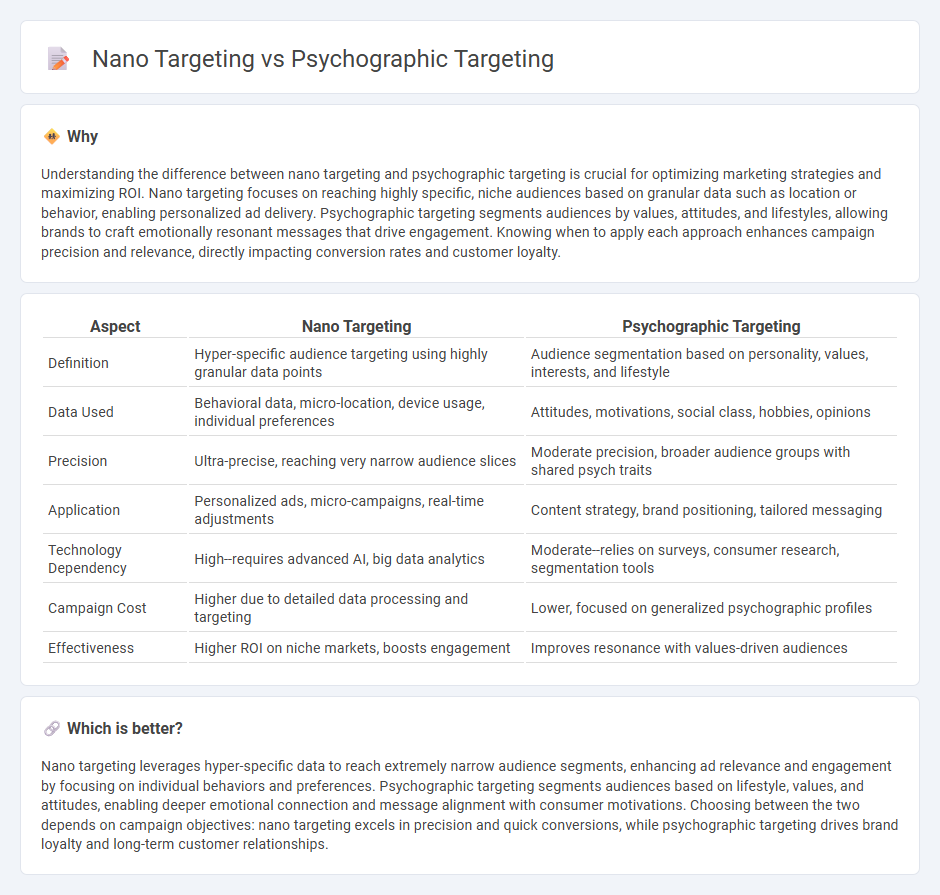
Nano targeting leverages hyper-specific data to reach micro-segments of consumers with personalized messages based on their online behavior and preferences. Psychographic targeting focuses on audience segmentation by analyzing psychological traits such as values, interests, attitudes, and lifestyle to tailor marketing strategies. Explore the nuances between nano and psychographic targeting to enhance your campaign precision and ROI.
Why it is important
Understanding the difference between nano targeting and psychographic targeting is crucial for optimizing marketing strategies and maximizing ROI. Nano targeting focuses on reaching highly specific, niche audiences based on granular data such as location or behavior, enabling personalized ad delivery. Psychographic targeting segments audiences by values, attitudes, and lifestyles, allowing brands to craft emotionally resonant messages that drive engagement. Knowing when to apply each approach enhances campaign precision and relevance, directly impacting conversion rates and customer loyalty.
Comparison Table
| Aspect | Nano Targeting | Psychographic Targeting |
|---|---|---|
| Definition | Hyper-specific audience targeting using highly granular data points | Audience segmentation based on personality, values, interests, and lifestyle |
| Data Used | Behavioral data, micro-location, device usage, individual preferences | Attitudes, motivations, social class, hobbies, opinions |
| Precision | Ultra-precise, reaching very narrow audience slices | Moderate precision, broader audience groups with shared psych traits |
| Application | Personalized ads, micro-campaigns, real-time adjustments | Content strategy, brand positioning, tailored messaging |
| Technology Dependency | High--requires advanced AI, big data analytics | Moderate--relies on surveys, consumer research, segmentation tools |
| Campaign Cost | Higher due to detailed data processing and targeting | Lower, focused on generalized psychographic profiles |
| Effectiveness | Higher ROI on niche markets, boosts engagement | Improves resonance with values-driven audiences |
Which is better?
Nano targeting leverages hyper-specific data to reach extremely narrow audience segments, enhancing ad relevance and engagement by focusing on individual behaviors and preferences. Psychographic targeting segments audiences based on lifestyle, values, and attitudes, enabling deeper emotional connection and message alignment with consumer motivations. Choosing between the two depends on campaign objectives: nano targeting excels in precision and quick conversions, while psychographic targeting drives brand loyalty and long-term customer relationships.
Connection
Nano targeting and psychographic targeting both focus on precision in marketing by leveraging detailed insights about individual behaviors, values, and personality traits. Nano targeting narrows the audience to a micro-segment based on psychographic profiles such as interests, attitudes, and lifestyle choices. This connection enables marketers to deliver highly personalized content that increases engagement and conversion rates.
Key Terms
**Psychographic Targeting:**
Psychographic targeting segments audiences based on interests, values, lifestyles, and personality traits, enabling brands to craft personalized marketing messages that resonate deeply with consumer motivations. This approach leverages data from surveys, social media behavior, and purchase history to understand emotional drivers behind buying decisions. Explore how psychographic targeting can elevate your brand's engagement and conversion rates with tailored communication strategies.
Lifestyle Segmentation
Psychographic targeting segments audiences based on lifestyle, values, interests, and personality traits, allowing brands to create personalized marketing strategies that resonate deeply with consumer motivations. Nano targeting narrows this approach further by focusing on hyper-specific micro-groups or even individuals, leveraging detailed behavioral and psychographic data for precision in messaging and product recommendations. Explore how these advanced segmentation techniques can transform your marketing efforts by delivering highly relevant content and enhancing customer engagement.
Personality Traits
Psychographic targeting zeroes in on personality traits, values, and lifestyle preferences to create highly personalized marketing messages that resonate deeply with specific audience segments. Nano targeting refines this approach by leveraging hyper-specific personal data and behavioral insights to target individuals at an extremely granular level, often using real-time analytics and AI-driven algorithms. Discover how integrating personality traits into these strategies can elevate your marketing precision and engagement.
Source and External Links
Psychographics: Definition & Marketing Use Cases - This page explains how psychographics can be used in marketing to segment audiences based on shared psychological traits like personality, values, and lifestyle.
How to Use Target Market Psychographics in ABM - This article discusses leveraging psychographic data for account-based marketing strategies to personalize messages and align with user needs.
Psychographic Segmentation: A Beginner's Guide - This guide provides an overview of psychographic segmentation, including its use in building detailed target market personas that combine demographic and psychographic data.
 dowidth.com
dowidth.com